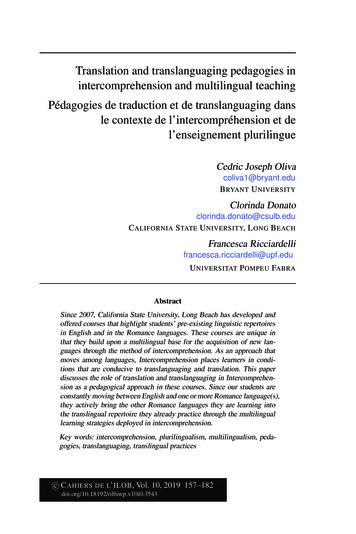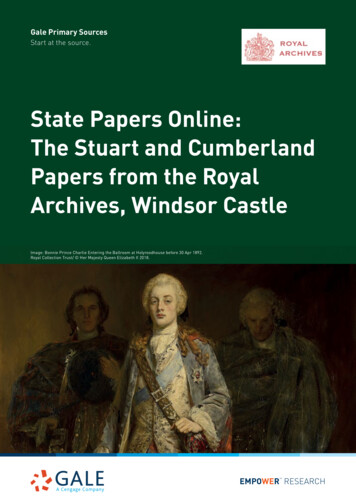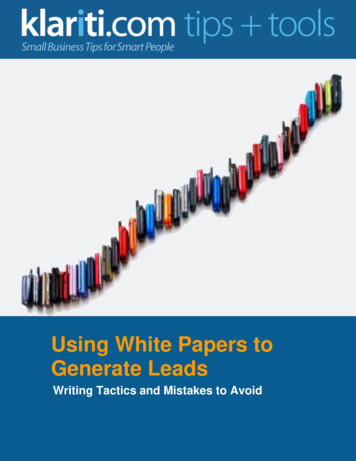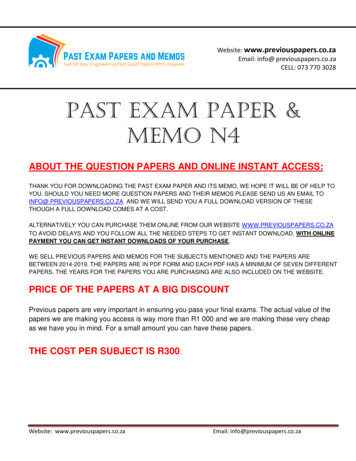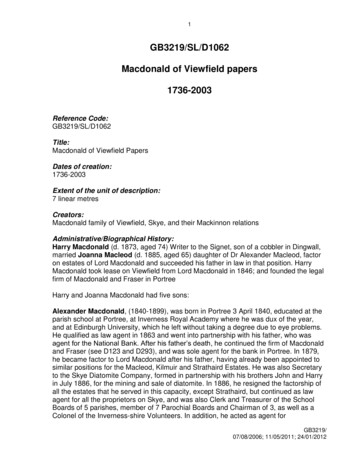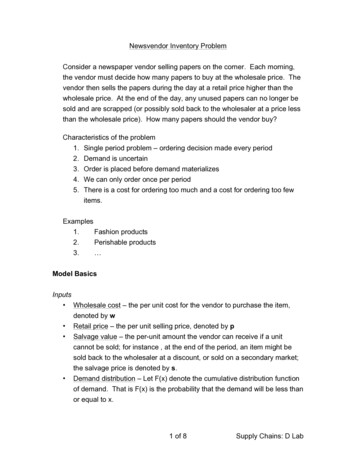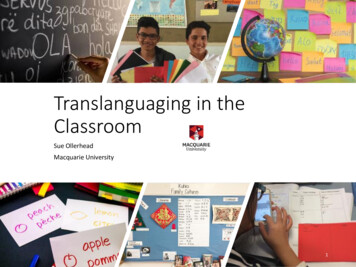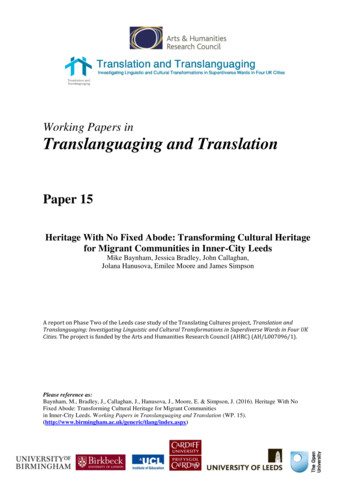
Transcription
Working Papers inTranslanguaging and TranslationPaper 15Heritage With No Fixed Abode: Transforming Cultural Heritagefor Migrant Communities in Inner-City LeedsMike Baynham, Jessica Bradley, John Callaghan,Jolana Hanusova, Emilee Moore and James SimpsonA report on Phase Two of the Leeds case study of the Translating Cultures project, Translation andTranslanguaging: Investigating Linguistic and Cultural Transformations in Superdiverse Wards in Four UKCities. The project is funded by the Arts and Humanities Research Council (AHRC) (AH/L007096/1).Please reference as:Baynham, M., Bradley, J., Callaghan, J., Hanusova, J., Moore, E. & Simpson, J. (2016). Heritage With NoFixed Abode: Transforming Cultural Heritage for Migrant Communitiesin Inner-City Leeds. Working Papers in Translanguaging and Translation (WP. ex.aspx)
AbstractThis paper reports on the second phase of the AHRC-funded Translation andTranslanguaging (TLang) project, on the theme of Heritage. The Key Participant for theHeritage theme in Leeds is Monika, a young Slovak Roma woman living and working ininner-city Leeds. Monika and her brother Ivan each aspire to setting up cultural spacesfor the Roma people in their area. The activities they hope to initiate will safeguard andtransmit to others that which is important to them – their heritage – including music,food, dance. As yet, there is no such space for the Roma in Leeds, and in this respect theyare attempting to make something happen where there is currently nothing. We followMonika in particular, as she attempts to bring her ideas into being. With the support ofothers, Monika tries to transform her available cultural capital into something that willpreserve and consolidate heritage but will also earn her a living. This she does bystarting to set up a social enterprise. Among other activities this entails the completionof a business plan. We follow her as the plan moves through stages of transformation,and in the process see her dreams and aspirations become both tangible and at thesame time constrained. In the later parts of the paper we examine familiar tokens ofcultural heritage, food and music, that play a part in the daily lives of Monika and herfamily, but which (in the case of food) Ivan is attempting to transform from cultural toeconomic capital, to make something that provides a living.2 Page
Executive SummaryThe second phase of the AHRC-funded Translation and Translanguaging (TLang) projectfocuses on the theme of Heritage. At the Leeds site, the Key Participant is Monika, ayoung Slovak Roma woman living and working in and around the ward of Gipton andHarehills, in inner-city Leeds. Monika and her brother Ivan each aspire to setting upcultural spaces for the Roma people in their area. The activities they hope to initiate willsafeguard and transmit to others that which is important to them – their heritage –including music, food, dance. As yet, there is no such cultural space for the Roma inLeeds: as we put it in this report, heritage has no fixed abode. In this respect Monika,Ivan, their family, and their friends and associates are attempting to make somethinghappen where there is currently nothing. We follow Monika in particular, as sheattempts to bring her ideas into being. With the support of others, Monika tries totransform her available cultural capital into something that will preserve andconsolidate heritage but will also earn her a living. She does so by starting to set up asocial enterprise, entailing the completion of a business plan. We follow her as the planmoves through stages of transformation, and in the process see her dreams andaspirations become both tangible and at the same time constrained. In the later parts ofthe paper we examine familiar tokens of cultural heritage, food and music, that play apart in the daily lives of Monika and her family, but which (in the case of food) Ivan isattempting to transform from cultural to economic capital, to make something that willbring them an income.We seek to address the following questions: How can heritage be understood in contexts of superdiversity and mobility? What are the linguistic and semiotic practices which contribute to the remakingof heritage in migration contexts? How do language and broader semiosis produce cultural spaces for thedevelopment of heritage-related activities?This report comprises seven sections. We begin by introducing Monika and her family,in the context of a discussion of Roma cultural heritage in Leeds. In Section 2, oncompeting understandings of heritage, we highlight the importance of space and thesearch for space. We draw on Lefebvre’s (1991 [1974]) notions of the social productionof space, and how it is negotiated and contested. Section 3 summarises ourmethodological approach, data collection strategies, and the data sets upon which thisreport is based. Section 4 is a study of Monika’s personal history: here we identify howshe draws on her cultural resources in her work environments, and her interactions infamily and social life, and include an overview of patterns of language use in her homeenvironment. In Section 5 we consider how her ideas about supporting the culturalheritage of Roma people are brought closer to fruition but at the same time aretransformed. She is advised to set up a social enterprise, and our focus is thedevelopment of a business plan for this. In Section 6 we turn to food and music, and thepart these play in the lives of Monika and her family: we examine how these are heritageresources which might also be commodifiable, might be transformed from cultural toeconomic capital, might become something that provides a living. The concludingSection, 7, summarises the report and its findings, noting how an understanding ofheritage has been both deepened and problematized through the process of thisresearch.3 Page
1 Introduction1.1 Remaking heritageThis is a report of the second phase of the Translation and Translanguaging (TLang)project, on the theme of Heritage. We focus on Monika, a young Slovak Roma womanliving and working in inner-city Leeds. Monika and her brother Ivan each aspire to setup cultural spaces for heritage-related activities for the Roma people in their area.When we began our work on this phase, early in 2015, we had three broad questions inmind. These were around the language and communication practices, the languagingand the translanguaging, that take place in superdiverse inner city Leeds, as it relates tothe theme of Heritage: How can heritage be understood, in contexts of superdiversity and mobility? What are the linguistic and semiotic practices which contribute to the remakingof heritage in migration contexts? How do language and broader semiosis produce cultural spaces for thedevelopment of heritage-related activities?As the study progressed, and as we came to know more of Monika, her family, hercircumstances and her aspirations, so our understanding of heritage deepened. Webegan to see heritage not simply as something that needs to be safeguarded from thepast for the future, though this is doubtless clearly evident here. Thinking about theremaking of heritage, our second question, forced attention onto other notions ofheritage which are also in play, in particular heritage practices. And our third questionled us to an examination of heritage spaces, and their production. We drew on Lefebvre(1991 [1974]) and on Li Wei’s theorisation of translanguaging space (2011) to developthe idea that space does not solely act as a backdrop or physical site for practice(including translingual practice), but is also co-produced by and in practice. Theunderstanding of heritage in superdiversity was therefore deepened by the study oflanguage and practice in the production of space.Searches for space become searches for funding, and as our observations carried on, sowe saw how heritage becomes commodified and transformed. Linguistic and discursiverepertoires around the creation of space for heritage were deployed by Monika andothers around her – sometimes successfully and sometimes less so, and with muchnegotiation. We developed our ideas about interdiscursive translanguaging: followingJakobson’s classification of translation (2012 [1959]), we describe interdiscursivetranslanguaging as the translanguaging across discourses which occurs when there isan unfamiliar discourse that needs to be negotiated. Above all, we gained anunderstanding of heritage as spatialized social and cultural practice, and of howlanguage, discourse and translanguaging practices can become heritage resources.So our study evolved to asking questions about what we actually wanted to call‘heritage’. Does our study of heritage being re-made for a new context, and without ahome, entail a redefinition of heritage? Would a new definition of heritage challengeestablished understandings of the term? What would it include or exclude? If heritage issocial and cultural practice, what, indeed, is not heritage? And finally, what does thissuggest about the role of heritage (as we re-define it) in the processes involved in4 Page
migration, settlement, and integration? These are some of the questions that emerged,and that we attempted to address, as we carried out the study.In the remainder of this introduction we meet Monika and her family, through whoseexperiences we sought our answers, and provide an outline of the rest of the report. Webegin with a preliminary overview of Roma cultural heritage in Leeds.1.2 Introducing Monika: Supporting Roma cultural heritage in HarehillsMy biggest dream to have something like castle, where I can have children whoabandoned, and I can give them life, grow them like care home. Second part of my lifeis still support other people like I do now.So says Monika, a young Slovak woman, our Key Participant (KP) in this phase of theTLang project. Monika aspires to support East European new arrivals in Leeds, and toprovide them with a space where they can participate in activities that relate to theircultural heritage.We first met Monika at Migration Counsel, an advocacy centre in Harehills, Leeds, one ofthe research sites in the first phase of the TLang project (see Baynham et al. 2015: 28).At Migration Counsel, she was working as the Roma Voice Worker, organizing activitiesfor Roma people in Leeds. We contacted Monika again before the beginning of thecurrent Heritage phase of the project, proposing that she might work with us as our KP.After some hesitation she agreed.From the beginning of our work on the TLang project in Leeds we have been gaining thesense that engaging Roma people in activities outside the scope of their family and theircommunity is something that many organizations set up to support new arrivals findchallenging. We also ascertained from informants in the first phase of the TLang projectthat getting the parents of Roma children involved in after-school projects and activitiesis likewise very difficult (see Baynham et al 2015). To be successful, said our earlierinformants, any such activity needs to reflect the cultural heritage of the Roma peopleand their social habits. Working with Monika, then, would allow us to explore the themeof Roma cultural heritage as it was being re-made, newly understood and developed inthe new context, the Harehills area of Leeds. Monika herself has a somewhat liminalposition with regard to the Roma in Leeds. She self-identifies as Roma, most of the time.She grew up in the south of Slovakia, near the border with Hungary, and spent a goodpart of her childhood in a children’s home (see Section 4 below). Her experiences in thechildren’s home, where Slovakian rather than a Romani language was dominant, have –as we see later – played a large part in her understanding of her relationship to theRoma in Leeds, as well as how cultural heritage might be understood in the newmigration context.During her time as our KP, the activities with which Monika was directly involved werethe Roma Voice meetings and the Women’s Group. Monika’s role with Roma Voice wasto develop participation of Roma people at the meetings. Drawing upon her knowledgeof social interaction among the Roma people, Monika advertised the meetings onFacebook, distributed leaflets translated into Slovak into schools and other places whichthey frequented, and worked on spreading the information by word of mouth. The5 Page
Women’s Group had been set up to address issues relating to health and domesticviolence. Knowing that these topics cannot be addressed directly, Monika was trying toattract the women with activities she thought they might enjoy (such as nail painting)before introducing more serious topics.Through her contacts with Roma people and the organizations working with them,Monika was aware that most activities provided to Roma in Harehills are linked toadvocacy and health. She identified a gap in terms of activities reflecting the culturalheritage of the Roma people. As Monika said: Many kids are talented, they want to dance,they want to sing, they have nowhere to rehearse, there is no-one to stand by them. Manymums stop me, please set up an arts school for us (LeeHerAud 20150611 JH 022).Through her contacts in the Leeds City Council, Monika started exploring the possibilityof obtaining funding to provide arts and dance-related activities for the Harehills-basedRoma in Leeds. How could she turn her ideas about supporting Roma cultural heritagein Leeds into a viable and sustainable venture? Monika’s endeavors to formulate andclarify her ideas about the services and activities she should offer, and to secure thefunding to do so, became a central focus of our observations, and an important part ofour analysis.Monika felt that the areas where she could make a positive contribution to the culturaland social life of the Roma were many – from arts and music activities for children andadults to English language classes and provision of advocacy – but were also at timesrather vague. We observed how support from Leeds City Council and other agencieshelped Monika develop her ideas in a structured way. Two people – Parmi, whoadministers Leeds City Council’s Bright Ideas fund, and Sharon, from IntegrityEndeavour, an agency supporting the development of small businesses – played keyroles in helping Monika. During our observation period, she was advised that her ideascould be shaped into a social enterprise. To apply for funding to initiate the enterprise,she had to complete a business plan form. In this process, as we shall see, the originalideas about providing activities relating to cultural heritage were narrowed, andsomewhat re-oriented towards the provision of advocacy. Moreover, the business planform had to be completed in writing, and although Monika had developed goodpresentation skills, she did not feel confident to fill in the application on her own. Afurther strand of this report, therefore, is how she gained assistance to complete theform. We pay particular attention to the involvement of Sharon and Parmi, and to howMonika cooperated with Jolana, the researcher on the TLang project, over the form’scontent and language.1.3 Monika’s familyIt was not only Monika who was thinking of setting up activities that would benefit theRoma community. Her brother Ivan and her sister Margita, who came to Leeds aroundthe same time as she did, also live in Harehills (see Section 4.2), and had parallelaspirations to ‘set something up’, shaped by their own dreams, abilities and experience.At the time of our observations, Ivan and Margita were also being supported by Parmiand Sharon.Margita hoped to found a cleaning company which would provide work to singlemothers in the area. Initially, Monika and Margita had been thinking of working inpartnership and sharing office space, but gradually they both reached the conclusion6 Page
that it would be better to work independently of one another. Ivan’s idea for anenterprise centred on food and music. His dream was to open a Roma café in Harehillsoffering food, some of it based on Slovakian dishes, as well as music-related activitiesfor the young people in the area. Another part of his plan was to promote music events,featuring Roma artists from Slovakia and the UK. When designing his own business plan,Ivan drew heavily on his experience in Slovakia, where he had volunteered for a charityorganizing musical events for the Roma. He also gained inspiration from activitiesorganized in other parts of Leeds and in Bradford.During our observation period Monika and her siblings spent a lot of time together,including time in Monika’s home where she lived with her then-partner Amir, and hertwo children Philippe and Christian. Recordings of domestic interaction have revealedgreat linguistic variety not just in Monika’s own communicative repertoire but acrossthe household: interlingual translanguaging is a normal part of everyday interaction.Whereas Monika and her siblings appear most comfortable communicating in Slovak,their children have a mostly passive knowledge of Slovak and prefer to speak in English.The adults all speak English, with a varying level of proficiency. Their linguisticrepertoires comprise elements of English and Slovak, often side by side in the speech ofMonika and her siblings, especially when talking to the children. Several members ofMonika’s family are also fluent in Hungarian, in addition to Slovak.1.4 OutlineThis report comprises seven sections overall. Following this introduction we discuss,with reference to relevant literature, what heritage might mean for Roma people inLeeds. We discuss how heritage might be identified in the context of this study,considering the commodification of heritage, and the social production of heritagespaces (Lefebvre 1991 [1974]).); in this section we propose an understanding of‘heritage of no fixed abode’. We follow this, in Section 3, with a summary of ourmethodological approach, data collection strategies, and the data sets upon which thisreport is based. We explain the roles of the project team: Leeds-based co-investigatorsMike Baynham and James Simpson, researchers Jolana Hanusova and John Callaghan,doctoral researcher Jessica Bradley, and visiting researcher Emilee Moore. Our centralanalyses begin in Section 4 with a study of Monika herself, her personal history, heridentity positions vis-à-vis the Roma in Slovakia and in Leeds, how she draws on hercultural resources in her work environments, and her interactions in family and sociallife. We also include an overview of language patterns evident in her home environment.We then turn in Section 5 to how her ideas about supporting the cultural heritage ofRoma people in Leeds are brought closer to fruition but at the same time aretransformed. She is advised to set up a social enterprise, and our focus is thedevelopment of a business plan for this. Our analyses extend to a study of interlingualand interdiscursive translanguaging practices as she completes the plan. We see howthe plan itself becomes a key actor in the process of making her ideas real andmarketable. The filling-in of the plan creates a space within which those ideas candevelop; but at the same time it constrains and narrows them, pulling her away fromher dreams. In Section 6 we examine familiar tokens of cultural heritage, food and music,that play a part in the daily lives of Monika and her family, but are also commodifiable,can be transformed from cultural to economic capital, can become something thatprovides a living. The concluding Section, 7, summarises the report and discusses itsimplications.7 Page
2 Heritage of No Fixed Abode2.1 Identifying HeritageInitially we struggled to identify the heritage theme in the life of our KP Monika. Wewere aware that heritage for Monika and those around her would be unlikely to appearas identifiable artefacts and practices that were the next in a chain of transmission tosubsequent generations of Roma people. This was confirmed as it became clear thatthere was no place or space in the Harehills area and around, where she lives and works,where Roma heritage was being curated and managed. Because of a lack of a spacewhere heritage was housed and practiced, there did not appear to be a great deal ofvisible evidence of what heritage might mean for Monika and other Roma in Leeds whohad arrived from elsewhere.In their book on the German diaspora in Canada, Liebscher and Dailey-O'Cain (2013)describe an interesting phenomenon: within less than a generation the regionalvarieties of German brought to Canada by migrants had levelled out and StandardGerman was characteristic. However regional variation – which could be understood asheritage – was maintained through social clubs, dance and music groups and cuisines.What is more a North German could find himself gravitating towards a South Germandance group. So for the German diaspora in Canada, heritage was in place, or we couldsay in places, in long-established venues and meeting places. Yet for a recently arrivedgroup like the Roma in Leeds there is no such sense of settled space or place to locate,identify and build an idea of heritage. The spaces which actually do emerge areborrowed, transitory. A hall in a primary school is used for Roma parties, untilpermission to use it is withdrawn due to too much noise. A pub is a focus for Romamusical events until it is closed down for infringing the licensing laws. Roma culturalactivities, therefore, take place in notably impermanent spaces. As we looked around wedid identify places where the borrowed space has become semi-permanent, places suchas the Thornbury Centre in Bradford, where a committed worker had built up links withlocal Roma families and networks leading to sustained use of the building. We foundnothing like this in Harehills.Additionally, as we carried out our fieldwork, we found many arts, cultural andcommunity organisations that would love to work with the Roma, but did not have therelevant contacts to do so. The ironical consequence was that on one hand a communitydesperately wants space for activities, while on the other, organisations – including‘heritage’ organisations like museums and art galleries as well as community artsgroups – have spaces and are longing to fulfil their diversity remit by working with theRoma, but can falter in their efforts to do so. One of the attempts to bridge this gap wasRoma Voice, designed to bring together Roma people with local organizations to createa dialogue and identify needs. Our KP Monika was the worker for Roma Voice.So we strove, with a certain amount of initial anxiety, to identify the heritage dimensionof the research. It appeared to us that there was literally nothing there, exceptaspirations, plans and dreams, those of both Monika and her brother Ivan. Andgradually it dawned on us that it was precisely these plans and dreams, the wish tomake something happen and for a place to do it, that were – for Monika and for us – theheritage focus.8 Page
At this point our reading was beginning also to tell us that heritage was at best acontested construct. We came across the crucial UNESCO definition of heritage:Cultural heritage is the legacy of physical artefacts and intangible attributes of agroup or society that are inherited from past generations, maintained in thepresent and bestowed for the benefit of future generations.Tangible heritage includes buildings and historic places, monuments, artefacts,etc., which are considered worthy of preservation for the future. These includeobjects significant to the archaeology, architecture, science or technology of aspecific culture.(UNESCO Cairo, n.d.)This made it clear that heritage could be both visible and invisible, in high profilebuildings and activities, but also in unobtrusive everyday practices. We will consider theUNESCO definition of intangible heritage below. We saw that heritage had taken the‘cultural studies’ turn, whereby heritage is evident in the small, everyday manifestationsof popular culture, and not just in the high profile iconic canons of art, architecture andliterature.A further problematizing issue for how we construct heritage comes when we considerheritage in the complex superdiverse settings in which we are researching. By definitionwe are talking about not one heritage but many: heritage in relation to migration anddiversity takes a multicultural turn. It then follows that not one but many traditionsbecome available in any given site, traditions relating for example to music or ways ofeating. Many if not all established definitions of heritage are locked into the notion of anintergenerational chain of transmission, by which cultural practices and artefacts arehanded down generation-to-generation. But what if there transpires some kind ofmarket place for cultural practices and traditions? We have seen this already in theLiebscher and Dailey-O'Cain study. The North German is not stuck with North Germantraditions: he can sample South German. In the new setting there is somethingapproaching a ‘pick-and-mix’ approach to heritage.Deumert (forthcoming) proposes the notion of multivocal local heritage discourses andheritage practices: heritage as repertoire. In superdiverse contexts we can think of howindividuals might make dynamic identifications with multiple heritage traditions. In acontext where more than one inheritance is available, people can adopt and identifywith cultural traditions that are not theirs by birth. Obvious examples are religiousconversion and coming out. If someone becomes a Muslim they insert themselves intoanother tradition, acknowledge another tradition. If someone comes out andsubsequently self-identifies strongly as gay, then somehow they are insertingthemselves into another chain of transmission, one for example where a National Trusthouse where in the past two men or two women lived together as lovers becomespersonal and moving. We can extend this also to affinity groups such as sports andmartial arts. In the phase of the TLang research that follows this heritage phase, westudy the practices around the Brazilian martial dance capoeira (Baynham et al.forthcoming). Many capoeira participants have assimilated themselves, often to a greatdepth, in the inherited practices of capoeira. At a certain point in our heritage phasefieldwork we were entranced by YouTube videos of Roma youth rapping effortlessly9 Page
with older Portuguese-speaking African rappers on a street corner in Harehills. Whoseheritage is being practiced here? Whose transmission? So our thinking about heritage,as the research evolved, came to distrust the simplistic mode, contained for example inthe UNESCO definition of one ‘community’ or ‘culture’ transmitting its heritage acrossthe generations. We struggled to find terms for heritage in an age and in a place ofsuperdiversity, thinking of mobile heritage, heritage on the move, heritage of no fixedabode. The lack of a space, a settled place, a node in the terms of Zhu Hua and Li Wei etal. (2015), is something particular to the current situation of the Roma. However thepervasive unsticking of heritage from settled chains of transmission is a much moregeneral phenomenon, of theoretical interest because of the light it throws onsuperdiversity as a construct.The idea of a multivocal approach to heritage in complex superdiverse settings, goingbeyond a simple notion of transmission within one community across generations, linkstherefore in an interesting way with the idea of repertoire. In linguistic terms, we seerepertoire as the range of styles and ways of speaking which a speaker has available. Webelieve that there is much scope in future work for exploring the ways that culturalheritage can be understood as or in relation to repertoire; that is, we can choose toextend our repertoire in terms of what is culturally and artistically available, learn tolike opera or drum and bass, just as we might extend our linguistic repertoire. As thestudy progresses we see how Monika and her family do not restrict themselves to acultural heritage repertoire that is supposedly Roma in nature, that is strictly linked toRoma inheritance. They too draw upon what is available, and appropriate it in theirmaking of a heritage for the future.A further factor to consider in the relationship between our KP and her own ‘heritage’ isthat she had a childhood shared between her family home and a children's home. In herinterviews and conversations she attributes an important role in her formation as aperson to her experience in the children’s home, and perhaps surprisingly in quite apositive way. So her heritage involves influences she took from her children’s homeexperience; in fact these are observable in the activities she plans in her project indevelopment. So there are aspects of her heritage which are quite clearly Roma butother aspects which come from somewhere else.All of these dimensions complicate, we would argue, the idea of heritage as a simplechain of transmission of a particular community to its subsequent generations.2.2 Heritage housed: A focus on the ‘heritage sector’For our KP in the heritage phase, as we have already established, ‘heritage’ is somethingthat is not housed in a museum or in an art gallery. We observe a heritage that is mobile,that is ‘on the move’, but wanting to find a home, to get housed. Here we considerestablished, housed heritage. We have noted above the irony that cultural artsorganizations in the area, because of their inclusion policies, were more than keen tomake contact with Roma and involve them in their activities. So how did the ways theyunderstood heritage influence our thinking?A recent collaborative research project funded under the AHRC’s ConnectedCommunities scheme investigating heritage decisions (How should decisions aboutheritage be made?) took for its definition of heritage that which ‘we value: places,10 P a g e p
and their social habits. Working with Monika, then, would allow us to explore the theme of Roma cultural heritage as it was being re-made, newly understood and developed in the new context, the Harehills area of Leeds. Monika herself has a somewhat liminal position with regard to the Roma in Leeds. She self-identifies as Roma, most of the time.
